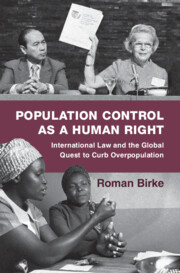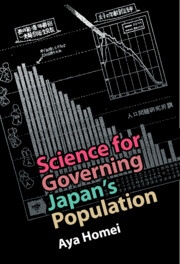Refine search
Actions for selected content:
26 results
1 - Introduction
-
- Book:
- Population Control as a Human Right
- Published online:
- 09 October 2025
- Print publication:
- 23 October 2025, pp 1-16
-
- Chapter
- Export citation

Population Control as a Human Right
- International Law and the Global Quest to Curb Overpopulation
-
- Published online:
- 09 October 2025
- Print publication:
- 23 October 2025
Tolerance, preferred sighting frequency and support for hunting of black bears (Ursus americanus)
-
- Journal:
- Environmental Conservation / Volume 52 / Issue 4 / December 2025
- Published online by Cambridge University Press:
- 06 August 2025, pp. 251-257
-
- Article
-
- You have access
- Open access
- HTML
- Export citation
Assessing neighbourhood-scale BTI spray applications and laboratory-based mortality testing on Aedes aegypti larval development
-
- Journal:
- Bulletin of Entomological Research / Volume 115 / Issue 1 / February 2025
- Published online by Cambridge University Press:
- 08 January 2025, pp. 56-65
-
- Article
- Export citation
A Glocal History of Post-independence Singapore’s First Sex Education Curriculum, 1966-1973
-
- Journal:
- History of Education Quarterly / Volume 64 / Issue 2 / May 2024
- Published online by Cambridge University Press:
- 07 December 2023, pp. 144-163
- Print publication:
- May 2024
-
- Article
-
- You have access
- Open access
- HTML
- Export citation
Regulation of Free-Roaming Cat (Felis Silvestris Catus) Populations: A Survey of the Literature and Its Application to Israel
-
- Journal:
- Animal Welfare / Volume 11 / Issue 2 / May 2002
- Published online by Cambridge University Press:
- 11 January 2023, pp. 171-188
-
- Article
- Export citation
Fertility Control: An Option for Non-Lethal Control of Wild Carnivores?
-
- Journal:
- Animal Welfare / Volume 7 / Issue 4 / November 1998
- Published online by Cambridge University Press:
- 11 January 2023, pp. 339-364
-
- Article
- Export citation
Stability of Breeding and Non-Breeding Groups of Golden-Headed Lion Tamarins (Leontopithecus Chrysomelas)
- Part of
-
- Journal:
- Animal Welfare / Volume 12 / Issue 2 / May 2003
- Published online by Cambridge University Press:
- 11 January 2023, pp. 251-268
-
- Article
-
- You have access
- Export citation
Welfare Implications of Culling Red Deer (Cervus Elaphus)
-
- Journal:
- Animal Welfare / Volume 9 / Issue 1 / February 2000
- Published online by Cambridge University Press:
- 11 January 2023, pp. 3-24
-
- Article
- Export citation

Science for Governing Japan's Population
-
- Published online:
- 10 November 2022
- Print publication:
- 17 November 2022
-
- Book
-
- You have access
- Open access
- Export citation
10 - Do It Now: Five Points of Leverage
- from Part III - Sensible Steps for Today’s World: Powerful Measures We Can Implement Right Away
-
- Book:
- Planet in Peril
- Published online:
- 13 October 2022
- Print publication:
- 13 October 2022, pp 133-159
-
- Chapter
- Export citation
Curbing the fruitfulness of self-replicating machines
-
- Journal:
- International Journal of Astrobiology / Volume 21 / Issue 4 / August 2022
- Published online by Cambridge University Press:
- 08 July 2022, pp. 243-259
-
- Article
-
- You have access
- Open access
- HTML
- Export citation
5 - The Briggs Plan
-
- Book:
- The Malayan Emergency
- Published online:
- 16 December 2021
- Print publication:
- 16 December 2021, pp 191-246
-
- Chapter
- Export citation
The intimate labour of internationalism: maternalist humanitarians and the mid-twentieth century family planning movement
-
- Journal:
- Journal of Global History / Volume 17 / Issue 3 / November 2022
- Published online by Cambridge University Press:
- 15 November 2021, pp. 515-538
-
- Article
-
- You have access
- Open access
- HTML
- Export citation
2 - The Tragedy of Garrett Hardin’s Commons
- from Part I - Revisiting the Origins and Evolution of Commons Thought
-
-
- Book:
- The Cambridge Handbook of Commons Research Innovations
- Published online:
- 29 October 2021
- Print publication:
- 11 November 2021, pp 26-33
-
- Chapter
- Export citation
Introduction
-
- Book:
- Tunisia's Modern Woman
- Published online:
- 20 May 2021
- Print publication:
- 03 June 2021, pp 1-37
-
- Chapter
- Export citation
Chapter 3 - Eugenics and Racism in the Development Episteme
- from Part I - Origins of the Development Episteme
-
- Book:
- The Idea of Development in Africa
- Published online:
- 16 October 2020
- Print publication:
- 29 October 2020, pp 58-78
-
- Chapter
- Export citation
8 - Fertility, Childbirth, and Parenting
- from Section 2 - Developmental Perspectives of the International Psychology of Women
-
-
- Book:
- The Cambridge Handbook of the International Psychology of Women
- Published online:
- 20 July 2020
- Print publication:
- 06 August 2020, pp 110-123
-
- Chapter
- Export citation
The Discursive Politics of Education Policy in China: Educating Migrant Children
-
- Journal:
- The China Quarterly / Volume 241 / March 2020
- Published online by Cambridge University Press:
- 07 February 2020, pp. 87-111
- Print publication:
- March 2020
-
- Article
- Export citation
1 - In the Hands of Physicians
-
- Book:
- Laboring for the State
- Published online:
- 09 January 2020
- Print publication:
- 23 January 2020, pp 39-90
-
- Chapter
-
- You have access
- HTML
- Export citation
